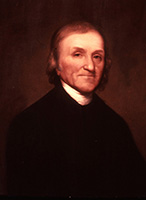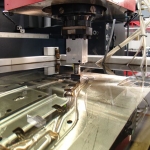A History of Electrical Discharge Machining


Electrical discharge machining is a cutting-edge machining technique that allows for great precision, even when working with tough materials. Many things that would have been impossible to make before the advent of EDM are now relatively easy, giving EDM a large role in facilitating the development of advanced technologies in pioneering industries, such as aerospace. The 20th century was a period of great advancement among all technical fields, which spurred the development of EDM. But the ultimate arrival of EDM was anticipated nearly two centuries earlier, by the scientist and philosopher Joseph Priestly.
Joseph Priestly was an 18th century Englishman who divided his ample time between the Church, philosophy, and scientific inquiry, which is reflected in his myriad achievements. The inventor of soda-water and a co-founder of Unitarianism, he also made various contributions to science. Best known for discovering oxygen, he also observed that electrical discharges eroded material from their electrodes. He had discovered the physical process that makes electrical discharge machining work. Having no idea as to the practical implications of this, however, the development of EDM would have to wait until the 20th century.


The 20th century saw a culmination in development of many important technologies that—when taken together—nourished each other to fuel an era of unprecedented technological achievement that has only continued to accelerate. The second half of the 1940’s in particular saw the beginnings of an international struggle between western powers and the Soviet Union, the impetus behind a vast expenditure on research and development on both sides. It was in this context that EDM was first developed, independently in the Soviet Union and United States. In 1943, B.R. and N.I. Lazarenko inadvertently found in their attempt to reduce the erosion of tungsten electrodes that erosion could be controlled when electrodes were immersed in dielectric fluid. This led to the development of one of the first EDM machines. In the United States, Jack Beaver, Harold Stark, and Victor Harding created an EDM machine in order to remove broken tools from cast aluminum. From improvised beginnings, the nascent potential of EDM spurred the disciplined development of more sophisticated machinery and techniques.
Die sink EDM was already established with the creation of the first EDM machines, but it was in the 1960’s that wire EDM was developed. A wire EDM machine is analogous to cheese wire. Unlike cheese wire, the wire in EDM is constantly being eroded by sparks. To combat this, wire EDM machines use large spools of wire. Fresh wire is constantly being supplied to the workpiece, which allows for smooth and continuous operation. The combination of this new technique with computer numerical controlled operation greatly expanded the uses of EDM, and left us with the EDM landscape we see today.
The history of EDM since that point has largely consisted of refining existing EDM techniques, and finding exciting new applications for the technology. EDM today plays an outsized role in the aerospace industry—small holes drilled with EDM can be found in just about every gas turbine engine and liquid fuel rocket nozzle. EDM is also found in all industries that require a high degree of precision, and where advanced, super-tough materials are used. These industries are some of the most dynamic in the world, their collateral effects on ordinary people profound. Hand in hand with industries such as these, the future of EDM looks bright.

